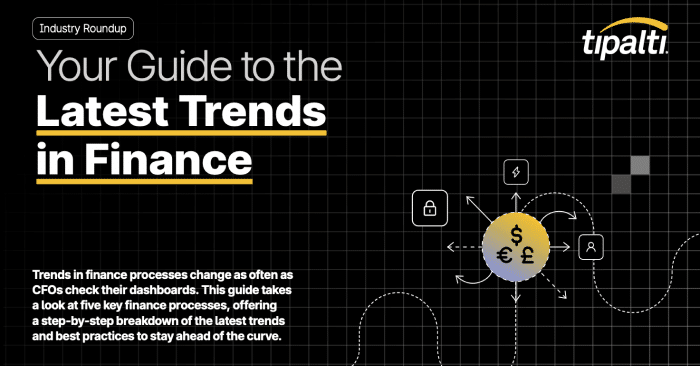
Finance trends shift fast—explore 5 key processes & tips to stay ahead.
Fill out the form to get your free eBook.

Trends in finance processes change as often as CFOs check their dashboards. This guide takes a look at five key finance processes, offering a step-by-step breakdown of the latest trends and best practices to stay ahead of the curve.
Cybercrime has become one of the defining business risks of our era. The pace, volume, and cost of attacks are escalating, particularly in industries that handle financial transactions. The global frequency of cyberattacks has more than doubled since the onset of COVID-19, with ransomware incidents surging to record highs. In 2023 alone, 72% of businesses worldwide were hit by ransomware, and the cost of these breaches shows no sign of slowing.
According to IBM, the average global breach cost rose in 2024 to $4.88 million, a 10% increase from the previous year. The financial sector, one of the most targeted industries, faces even higher averages—around $6.08 million per breach. Meanwhile, ransomware payments exceeded $1 billion globally in 2023, the highest on record.
With these statistics, it’s clear that cybercrime is one of the most pressing operational risks for global businesses, exacerbated by the convergence of complex supply chains, heightened regulatory demands, and the expansion of digital payment networks. With cybercriminals exploiting vulnerabilities faster than ever, organizations must strengthen security, safeguard online operations, and invest in technology that turns defense into a strategic advantage.
Why Cybercrime Is Rising
The question is not whether businesses will be targeted, but why attackers are increasingly successful. Three primary drivers stand out:
1. More Sophisticated Attacks
Attackers have adopted advanced technologies, including AI, to supercharge their methods. Phishing emails, once riddled with spelling errors, are now virtually indistinguishable from legitimate communications. Deepfake audio and video have been used to impersonate executives, while AI-generated invoices mirror a company’s formatting and tone with complete precision.
2. Expanding Supply Chain Vulnerabilities
Modern finance depends on networks of global vendors, APIs, and SaaS platforms. Each integration is a potential entry point. High-profile breaches in recent years have often stemmed from vulnerabilities in third-party providers. This growing complexity means organizations are only as strong as their weakest partner.
3. Regulatory and Compliance Pressure
Frameworks like GDPR, PCI DSS, and PSD2 aim to raise the bar on cybersecurity. Yet compliance itself can strain resources. As companies balance innovation with regulatory obligations, attackers exploit the cracks created by overstretched teams and legacy systems.
Payments Are a Prime Target
Among all business functions, accounts payable and global payouts are uniquely vulnerable. These systems handle large volumes of sensitive vendor and banking data, making them ideal targets for financially motivated attackers.
Direct Financial Impact
Business Email Compromise (BEC) stands out as one of the most expensive cyberattack methods, as fraudsters impersonate trusted parties to reroute payments. Additionally, invoice fraud poses a significant threat, with altered or fabricated invoices infiltrating manual workflows and taking advantage of weak validation processes. Cash flow attacks are another tactic that targets individuals who have access to funds, using urgency or deception to coerce them into granting approvals.
Operational and Data Security Risks
Ransomware attacks can severely disrupt operations by locking down AP or ERP systems, forcing companies to halt their activities until the ransom is paid. Additionally, the sensitive data stored within these AP systems, such as vendor and banking information, presents an opportunity for attackers who want to exploit this information. The reliance on manual processes, including spreadsheets, emails, and handoffs, also introduces multiple vulnerabilities that can create opportunities for fraud.
New and Evolving Threats
Attackers are increasingly employing social engineering tactics at a large scale by customizing phishing campaigns using publicly available data from companies. Generative AI is also being used to create convincing fake invoices, contracts, and communications, making it harder to detect fraud. Additionally, fraudsters exploit vendor onboarding processes and can redirect global wire transfers through shell accounts, employing advanced payment tactics to carry out their schemes.
Global Risks
The complexity of cross-border transactions, which vary across different banking standards in various countries, can lead to significant blind spots in fraud detection. The presence of systemic risk is also heightened by breaches that can occur at processors or clearinghouses, posing a threat not only to individual companies but to entire financial ecosystems.
Using Technology as a Defense Shield
Contrary to concerns that digitization creates more risk, automation can, in fact, mitigate the biggest vulnerabilities in AP and payout workflows. By reducing manual touchpoints and embedding advanced controls, automation shifts the balance back to defenders.
Automation strengthens payment security by systematically addressing the weak points that cybercriminals target. By removing manual steps, it reduces the likelihood of human error—a common gateway for fraud. Invoices can be automatically validated against purchase orders and historical records, exposing duplicates or inconsistencies before funds are released. Secure, role-based approval workflows ensure no single individual becomes a point of failure, while digital payment tools restrict exposure by limiting transactions to specific vendors or amounts.
Machine learning and agentic AI further enhance resilience by monitoring for anomalies such as sudden invoice spikes, unusual vendor changes, or suspicious login activity. Every action is logged in audit trails, achieving regulatory compliance and creating accountability. Combined with strong encryption, multi-factor authentication, and access to global KYC and AML databases for vendor validation, robust technology solutions can help create a layered defense that is far harder for attackers to penetrate.
A Cybersecurity Roadmap for Business Leaders
To navigate this new battleground of cybercrime across operations, business leaders should focus on five priorities:
1. Eliminate Manual Processes
Start with the highest-risk workflows, replacing spreadsheets and email-driven approvals with secure automation.
2. Select Secure Platforms
Work only with providers that embed advanced fraud detection, vendor verification, and compliance controls.
3. Educate Employees Continuously
Regular training on phishing, invoice fraud, and deepfake scams is critical.
4. Continuously Validate Vendors
Ongoing vendor monitoring, not one-time onboarding checks, is essential.
5. Invest in Incident Readiness
Establish playbooks for ransomware, diversion fraud, and supply chain breaches, including recovery and communications plans.
At the Frontline of Cyber Defense
Cybercrime is no longer a sporadic risk—it’s an accelerating threat. For finance and operations teams, particularly those overseeing AP and global payouts, the implications are clear. Fraud, ransomware, and vendor impersonation are now part of the daily operating environment.
But resilience is achievable. By embracing technology, enforcing strong identity controls, and continuously monitoring transactions with agentic AI, organizations can significantly reduce their exposure. Cybersecurity will no longer be reactive—it will be embedded into every step of the payments workflow.
In today’s business environment, automation is not just a tool for efficiency—it’s a cornerstone of defense and a strategic imperative for safeguarding trust, building financial stability, and preparing for long-term growth.
